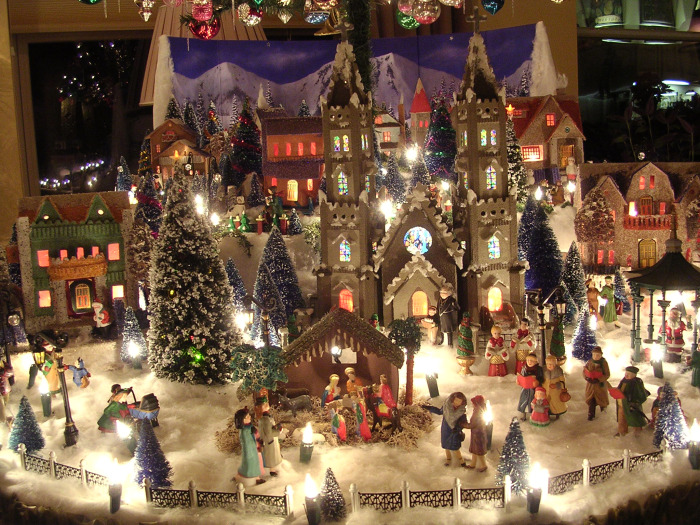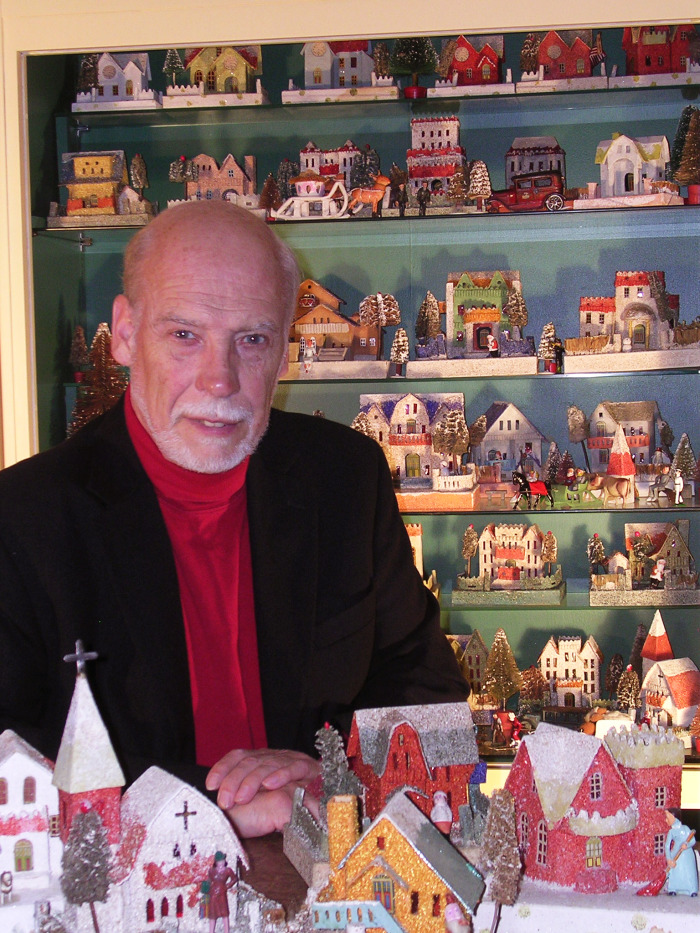The History of the Putz Village
and Cardboard Christmas Houses
By Pete Oehman
Most of us get a warm, fuzzy feeling when we think of Christmas and automatically reflect upon our childhood memories. Christmas trees bedazzled with lights and ornaments, wreaths, stockings hung by the chimney and all the wondrous decorations that would make any child’s heart flutter with anticipation. For me it was a visit to my grandmother’s house. Nanny’s house was a showplace for all things eclectic, but Christmas time was special.
As a small child, I was always drawn to the creche scene under the Christmas tree. After making sure the baby Jesus was safely tucked away in his crib, my eyes would gravitate to the village that surrounded the manger. Little cardboard houses were carefully placed atop the cotton-batting snow. The village was populated with Barclay lead figures. The skaters were placed on a mirror to create the illusion of a frozen lake. Street lamps and cars were strategically placed, and when lit up, the whole scene would be brought magically to life. I fell in love with the little cardboard houses. Every year I could hardly wait to see the new ones that had been added to the display. Those were the Christmas memories that later turned me into a collector of putz houses.
My grandma always referred to these villages as a putz. When I asked her what that meant, she said, “It’s German for putting or placing things together to create a scene.” Later I learned it comes from the German word putzen which means to decorate or adorn.
The putz tradition had its start in Central Europe, including Bohemia and Moravia which are now part of the Czech Republic, and Slovakia. Because the Moravian’s were part of an older Protestant church, they were persecuted by other religious movements. When their numbers dwindled, due to a series of religious wars, they immigrated to America. Once they were here they founded Bethlehem, Pennsylvania on Christmas Eve in 1742.
Celebrating Christmas was an important part of the Moravian culture. One tradition was the elaborately constructed Christmas scenes that portrayed the Christmas story or other religious themes. These scenes known as putzes have been traced to the late 1700’s in this country.
The original putzes started with family members, mostly the children, going out to the woods in late autumn to collect stones, moss, ferns, lichens and twigs. The large stones were used for mountains, small branches of cedar and pine for trees. In later years pieces of tinfoil were used to represent a waterfall; a mirror was used as a lake. All sorts of animals were added to bring the scene to life. There is no scale in a proper putz; a three inch all cat can sit beside a two inch tall cow.
The Moravians were known for adding villages to their scenes. From the late 1700’s until the late 1800’s simple handmade and elaborate castles decorated the landscape. It wasn’t long before small, hand-carved people populated these villages. At the center of all the creation lay the creche, the hallmark of the traditional putz.
The Industrial Revolution was about to add new dimensions to the putz scene. The Germans were already masters of the glass Christmas ornaments and the American people couldn’t get enough of these sparkling treasures. They also started making little cardboard houses with hand-stamped doors and windows. The exterior walls were adorned with hand-painted flowers and bushes. The Erzgebirge region in Germany was famed for its toy building and America was hooked.
WWI changed the way we did business. Germany was no longer meeting our needs for all things Christmas. The Butler Brothers of Chicago and F.W. Woolworth were two well-known proprietors that created the concept of the local “dime store”. These stores sold Christmas decorations that the average family could afford.
With Germany out of the picture they set their sights on other manufacturers and Japan seemed like the perfect partner. Although the Japanese did not understand our Christmas traditions, they used their industrious ingenuity to create many of our much sought after Christmas collectibles. The 1920’s found many of our Christmas trees ablaze with the new inexpensive string lights. With our fondness for bright and sparkly items the Japanese found many ways to satisfy our appetite and the phrase “Made in Japan” became part of our vocabulary.
Nobody knows for sure who brought the idea of making little cardboard houses to the Japanese. Somewhere around 1927-28 I’m sure a purchasing agent from one of the “Five and Dime” stores brought some pictures of American homes to a Japanese manufacturer and asked what they might be able to design and build. The first houses were box-like candy containers and later versions had a hole in the back for filling with candy. A moveable cardboard disk held the candy inside. No one knows for certain who came up with the ingenious notion to put a light into the round opening in the back of the houses and use them to create an illuminated village under the tree. I, for one, am sure glad they did!

Much to the delight of vintage Christmas collectors, such as Golden Glow members, these little houses sat next to hundreds of Japanese decorative innovations at the “Five and Dime” store and became just as popular as Christmas lights themselves. The variation and quantity that the Japanese produced in such a short time was amazing. When I first started compiling my Collector’s Guide, I believed there might be as many a 200, maybe 300, different houses. My collection, alone, has an unbelievable 3000 specimens and I see new styles popping up on eBay all the time. WWII all but put an end to the cardboard putz house. Germany and Japan
were now our enemies which ended our commerce with these warring nations. Our country put a lot of material and energy into the war effort but that did not crimp our celebration of Christmas. The Dolly Toy Company and the Colmor Company started creating their own interpretations of the cardboard putz house. The “Made in USA” houses where never made with the same charm as the prewar houses, but we still had a supply to use in our putz villages. After the war, the Japanese started to make cardboard houses for the American market again. There was a small spurt of the original charm in these houses up until the early 1950s. After that, they
became smaller, flimsier, and a lot simpler. Somewhere around the middle 1960s the little putz house had all but vanished.
In future articles I will go into more depth about the different time periods, classes, styles, structures, materials and collectibility of these little gems.
ABOUT THE AUTHOR: Pete Oehman has been collecting and documenting the history of cardboard putz houses for years. He currently operates a wonderful website where he sells replacement cellophane doors and windows for old putz houses. You can order replacement doors and windows and read more about Pete’s hobby at cardboardputzhouses.com.


